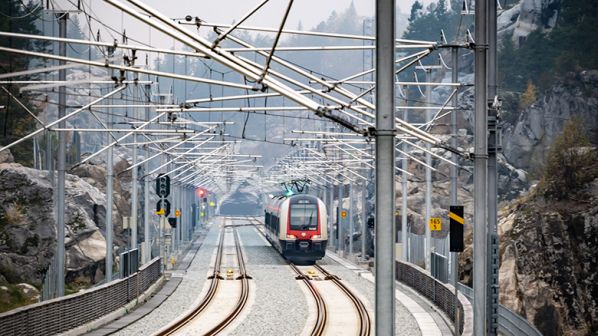THE transport sector accounts for a third of climate emissions in Norway, with road traffic the leading source, and air a major and sea traffic a minor contributor. Conversely, the railway is emission-free. Or, to be exact, Norway’s use of diesel traction accounts for just 0.3% of all transport CO2 emissions, and we are working to phase this out.
However, if Norway is to meet our international obligations to reduce greenhouse gas emissions, investing in the railways must be part of the solution.
Before the Covid-19 pandemic, the need for transport was constantly increasing in and around our larger urban areas. While road traffic in the most populated areas was on the up, we also saw explosive growth in the number of rail passengers. With urban areas set to continue to grow, the need for transport is likely to continue to increase when the pandemic is over and society is back to normal.
The Norwegian government therefore must continue to focus on public transport. Politicians have set a goal to halt the increase in car use in urban areas and the growing need for mobility will instead be met by cycling, walking and public transport options that will reduce emissions and to make transport more efficient. It is not socio-economically profitable for people to be stuck in a traffic jam, which only results in pollution, energy consumption and irritation.
We have noticed that some commentators believe that new technology alone can solve the transport needs of the future. We welcome investment in innovations and more electrically powered transport. However, we must not stop investing in rail, which can carry more passengers while still being completely emissions-free and very energy efficient. This gives the railway a clear advantage in populated areas, and when goods need to be transported over longer distances.
Rail transport also requires less space than roads. And with no green field sites available, new road infrastructure will inevitably have a greater impact on natural habitats, farms, cultural monuments and existing buildings than railway tracks, which offer a reduced footprint. In addition, the roughly 3.3 million cars and vans in Norway require a lot of space for parking. This makes the railway far more area-efficient than road traffic.
Cutting emissions during construction
An objection to rail is that while operation is emissions free, construction of a line is resource intensive. However, this is the same for construction of any infrastructure, including railways, roads or large buildings. Inevitably the size and location of the structure determines the volume of greenhouse gases emitted and we at Bane Nor are continuously working to reduce emissions by:
- usinge the least polluting concrete
- limiting the length of bridges and tunnels during planning of projects to reduce the volume of materials required
- setting increasingly stringent requirements for emissions at construction sites, which we aim to electrify within a few years, and
- participating in research projects with the goal of reducing the use of cement for soil stabilisation.
At the same time, we are setting stricter environmental requirements in our contracts, and encouragingly are seeing our suppliers reduce their emissions more than we expected.
We are also looking for solutions that continue to improve the railway’s green footprint. In Drammen, for example, we will cover the platform roof at the new station with solar panels to provide completely clean and sustainable power for the station. In addition, when a new railway is completed, passengers and freight can be transported on the line emissions free, thus “paying for” the emissions generated during the construction phase. This makes the railway unbeatable in terms of sustainability.
Focus on the environment, focus on railways!
Norway faces some major challenges in the coming years. We are aiming to reduce our fossil fuel emissions by up to 55% by 2030, and the road, aviation and shipping sectors will require large amounts of resources to fully decarbonise by 2050.
Today, road carries around 14 times more people and 10 times more freight than rail, meaning we are completely dependent on a well-developed road system in Norway, both for private journeys and commercial traffic. Bane Nor wants to see good, fast and efficient transport routes throughout the country. In many places, using roads is unavoidable, but in other places the railway can be more efficient to help take some of this load. Road also has some major environmental limitations which should be taken into account when considering whether it is optimal to invest in a road or rail project:
- new calculations show that the wear on tyres, brakes and the road emits more than 8000 tonnes of microplastic every year. This accounts for 40% of Norway’s total microplastic emissions, which spread across the land and sea. The railway has no such emissions.
- road traffic is the largest source of local air pollution from exhaust, and wear particles from roads, tyres and brakes. In Norway, we lose a total of 15,200 healthy life years annually due to airborne dust. The railway does not affect air quality, as while wear and tear does occur, this remains on the track.
- road maintenance releases more than 250,000 tonnes of chemicals and salt every year, which affects waterways in several places across the country. The railway’s total annual chemical use is 4000 litres of glyphosate. We have strict control over the use of the herbicide and make an effort to keep the environmental impact to a minimum, and
- road traffic accounts for 60% of the energy used in the transport sector. Rail uses 1% and is constantly working to reduce this figure.
In short, railways are the most climate and environment-friendly mode of transport now, and they will continue to be for the foreseeable future. The government should therefore get behind rail and offer the support it requires.
(Sources: Statistics Norway, Statkraft, Norwegian Environment Agency, Norwegian Public Roads Administration, Norwegian Railway Directorate, regjeringen.no)

